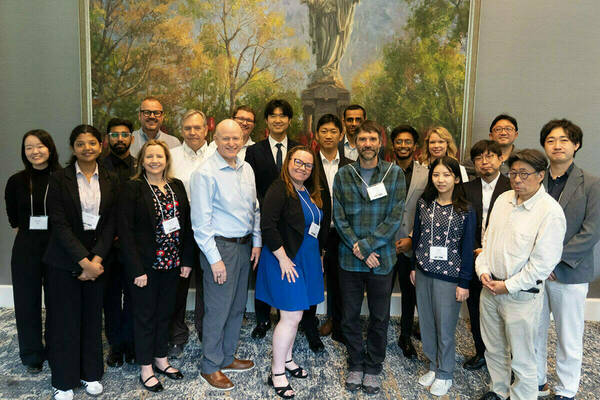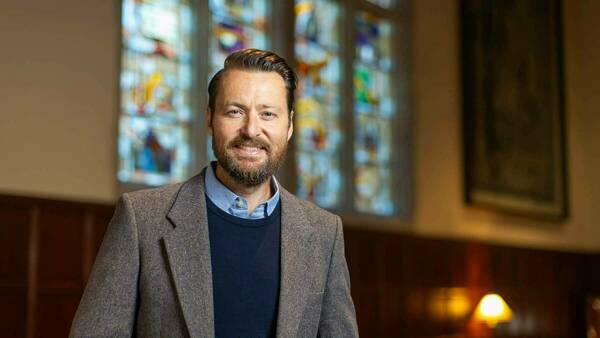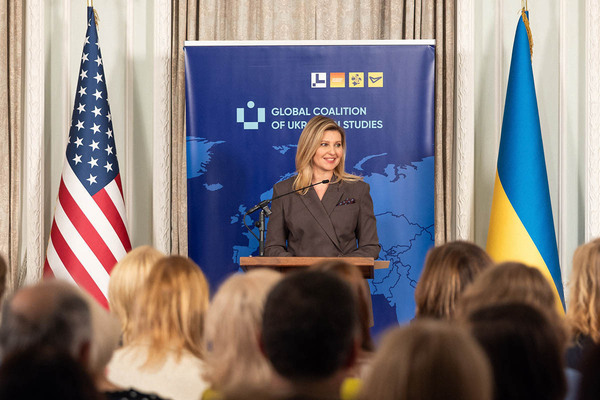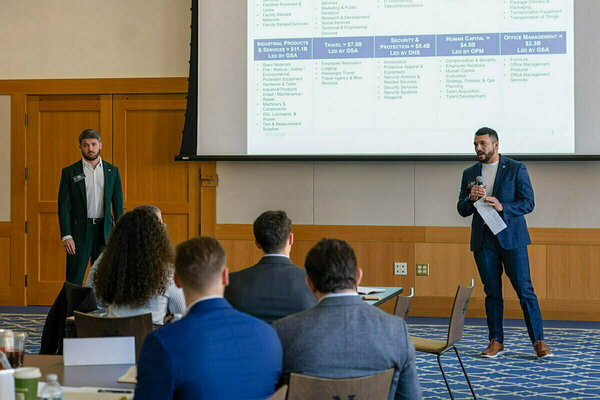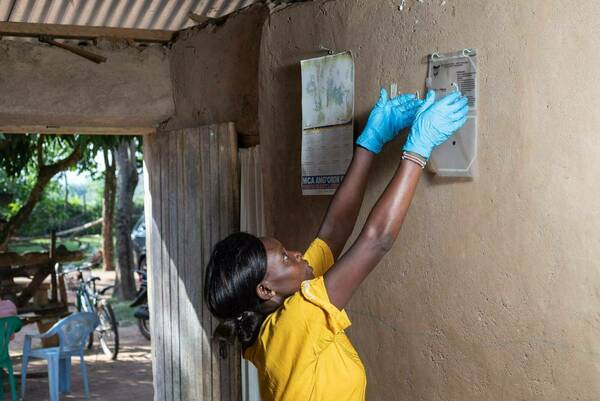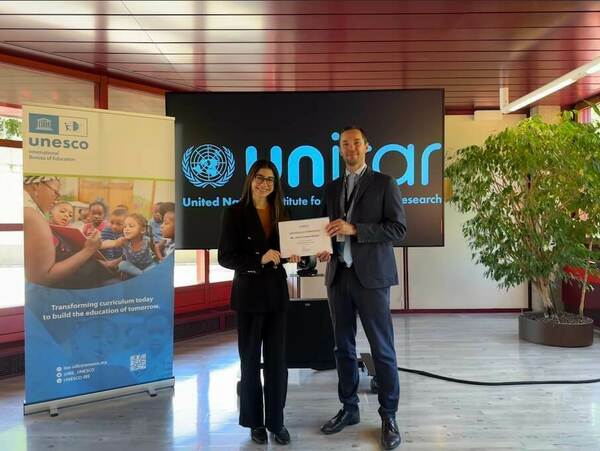NSF Cyber SMART’s fall meeting shapes fifth year of project, legacy and future plans, and adds new member
The U.S. National Science Foundation (NSF) Cyber SMART center gathered for its fall meeting on the University of Notre Dame campus this September. The meeting served as a checkpoint with progress reports and new projects from research leads and students who are members of the center. The center meeting attendance included multiple industry and federal partners, as well, including IQI Balanced Intelligence, NEC Corporation, Washington CORE, Sumitomo Mitsui Trust Bank, and others.
The NSF Cyber SMART center, with its acronym meaning Science, Management, Applications, Regulation, and Training, was formed by its lead institution, Georgetown University. Today, the NSF Industry-University Collaborative Research Center (IUCRC) has grown to include Virginia Tech, the University of Notre Dame, and the University of Technology Sydney.
The meeting opened with remarks from Jarek Nabrzyski, Cyber SMART executive director and site director for the University of Notre Dame, and Ophir Frieder, Cyber SMART director and professor at Georgetown University and at the Georgetown University Medical Center.

“During our meeting, we received critical updates and fascinating insights from our researchers across member institutions,” said Nabrzyski, reflecting on the meeting. “The presentations sparked interesting discussions across institutions, and showcased practical examples of how we can use computer science to do good in the world.”
As part of the meeting, center leadership scheduled sessions to talk about funding priorities and how it will plan to propose the continuation of the project.
Frieder said in his remarks that the NSF wanted the center to grow internationally.
“We were informed that Cyber SMART was the first IUCRC site to involve the Australian continent,” said Frieder.
In December 2024, NSF Cyber SMART leadership traveled to Australia to officially welcome the University of Technology Sydney as its first international site. During the visit, leadership met with April Palmerlee, chief executive officer of the American Chamber of Commerce in Australia, and chairman of the American Chamber of the Asia Pacific.
Since then, Shin’ichiro Matsuo, site director for the Georgetown University site, lead researcher in the blockchain ecosystem, and research professor at Georgetown University, has also been appointed by the Financial Services Agency of Japan to serve as a special expert member for its working group on crypto-asset regulation.
The leadership also considered the membership of Irys, and later confirmed that the company would officially join the NSF CyberSMART center as of November 1st. Irys is a company that works with geolocation data worldwide, adding new privacy enhancing technologies for applications using this data.
“With Irys as a center member, we are excited to work together to explore more applications of innovative location data technologies,” said Nabrzyski. “Each member of our center brings a fresh perspective and expertise to continue our mission.”
The center’s mission is to use computer science strategically to address real-world problems that both NSF and industry want to address. Frieder rallied behind those values in his opening remarks.

“The real questions are ‘why do we actually want to continue?’ and ‘what would we want to be the Cyber SMART legacy?,’” he said. “Technology, on its own, is kind of meaningless. Keeping people healthy and safe is the goal. Feeding people is the goal. That is and should be our center’s goal. We need to put ourselves in ‘the why,’ so that what we are doing actually matters.”
Throughout the morning, research presentations were given to both the in-person and virtual attendees of the meeting. The presentations included:
-
Decentralized Privacy-preserving Authentication / Identification w / DID (Decentralized identifier) and VC (verifiable credentials), given by Kigen Fukuda, of Virginia Tech.
-
Digital Asset and its Governance, given by Shin’ichiro Matsuo, Takuya Kobori, and Takashi Kaneko, of Georgetown University.
-
Trustworthiness of AI, given by Shohei Mitani, Georgetown University
-
LAYER 2 Blockchains and Smart Contract Security, given by Shin’ichiro Matsuo, Georgetown University.
-
Policy CPS (cyber-physical systems), given by Tatsuya, of Georgetown University, and Erika Heeren-Moon, of Virginia Tech.
-
Development of the MIMI Protocol for Cross-Platform Messaging Interoperability, given by Srinidhi Amuri and Henry (Hyungmin) Kim, of Virginia Tech.
-
Building a Resilient, Thriving South Bend Through a Token-Based Community-Governed Digital Cooperative, Jarek Nabrzyski, University of Notre Dame
-
New Project: Communications Reliability, Eric Burger, Virginia Tech.
The meeting proceedings updated members across the center on the research being done and advances being made. The fall meeting shapes the next year of Cyber SMART’s research focuses and projected output as the academic calendar launches for the year.
Learn more about the center’s research focuses here: https://cybersmartcenter.org/research/
About Cyber SMART
NSF Cyber SMART is a U.S. National Science Foundation (NSF) Industry-University Collaborative Research Center (IUCRC). Its participating research institutions include Georgetown University, the University of Notre Dame, the University of Technology Sydney, and Virginia Tech.
To learn more about Cyber SMART, please visit cybersmartcenter.org
Contact: Christina Clark, Research Communications Specialist
Cyber SMART / Notre Dame Research / University of Notre Dame
cclark26@nd.edu / 574.631.2665
Originally published by at cybersmartcenter.org on October 01, 2025.
Latest Research
- Slavic and Eurasian studies professor wins Humboldt fellowship to research how Russia’s religious past shapes its presentWhen Russia invaded Ukraine on Feb. 24, 2022, Sean Griffin realized his second book needed a new title. Griffin, an associate professor in the University of Notre Dame’s Department of…
- Notre Dame’s R.I.S.E. AI Conference builds interdisciplinary collaboration to inform human-centered artificial intelligenceAs artificial intelligence (AI) transforms nearly every sector of society — from healthcare and education to governance and global development — a critical question emerges: How can we conscientiously design and deploy these powerful technologies to positively impact society? This…
- University of Notre Dame joins the Global Coalition of Ukrainian StudiesThe University of Notre Dame has joined the Global Coalition of Ukrainian Studies after signing a Memorandum of Cooperation (MOC), formalized on September 24, 2025, at the Ukrainian Institute of America in New York City. Notre Dame joined four other American…
- The University of Notre Dame’s Mendoza College of Business and Industry Labs team up to inspire national security manufacturing competitiveness in the regionThe South Bend - Elkhart Region is full of manufacturing companies that are poised to grow, and Executive Master of Business Administration (EMBA) and Master of Business Administration (MBA) students at the University of Notre Dame are finding innovative ways to contribute to that growth. Earlier…
- Notre Dame research informs WHO conditional recommendation for spatial repellents in malaria vector controlThe World Health Organization (WHO) recently announced a “conditional recommendation” for spatial emanators, also known as “spatial repellents,” in the fight against malaria. This key determination was informed by spatial repellent studies that included the Advancing Evidence for the Global Implementation of Spatial Repellents (AEGIS) Project in Kenya, led by the University of Notre Dame and funded by Unitaid. The findings from this particular study were recently published in The Lancet.
- Walking the Halls of Global GovernanceOutside the Palais…



